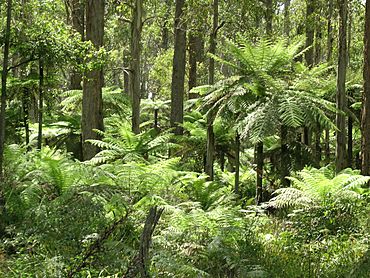Werrikimbe National Park facts for kids
Quick facts for kids Werrikimbe National ParkNew South Wales |
|
|---|---|
|
IUCN Category Ib (Wilderness Area)
|
|

Tree ferns in Werrikimbe National Park
|
|
| Nearest town or city | Walcha |
| Established | 11 July 1975 |
| Area | 333 km2 (128.6 sq mi) |
| Managing authorities | NSW National Parks & Wildlife Service |
| Website | Werrikimbe National Park |
| See also | Protected areas of New South Wales |
Werrikimbe National Park is a special protected area in New South Wales, Australia. It's located near the Hastings River, about 486 kilometers north of Sydney. The park was officially created in 1975 and covers a huge area of 33,309 hectares (that's about 333 square kilometers!).
This park is super important because it's part of the Gondwana Rainforests of Australia. This group of rainforests is so unique that it's listed as a World Heritage Site. This means it's recognized globally for its amazing natural value!
Contents
What Makes Werrikimbe Special?
Werrikimbe National Park is famous for its incredible variety of plants and animals. It has beautiful rainforests, wild rivers, and lots of untouched wilderness. It's a great place for outdoor adventures, especially if you like remote areas.
The park also holds special meaning for Aboriginal people. You can find ancient stone arrangements here, including "bora rings." These rings were once used for important ceremonies and gatherings.
Visiting Werrikimbe: How to Get Around and Where to Stay
Getting to Werrikimbe National Park can be an adventure itself! The roads leading into the park are gravel, winding, and can be steep. They are not suitable for caravans, so keep that in mind if you're planning a trip.
If you want to reach the Youdales Hut area, you'll need a four-wheel drive (4WD) vehicle with low range. You also need to get a key for the locked gate beforehand. You can get this key from the National Parks and Wildlife Service or from Apsley Motors in Walcha.
There are five main visitor areas in the park with basic facilities. Three are on the eastern side, and two are on the western side.
You can camp at these spots:
- Brushy Mountain campground: This campground has 20 sites. You can park your car and trailer right next to your campsite (but no caravans). It has toilets, picnic tables, and wood barbecues.
- Mooraback campground: This spot has 5 sites at the park's north-western end. It offers toilets, picnic tables, and wood barbecues.
- Plateau Beech campground: Located on the eastern side, this campground has 5 sites. You'll need to walk a short distance from your car to your tent here. It has pit/composting toilets, picnic tables, and wood barbecues.
The Bicentennial National Trail, a long track for walkers and horse riders, goes through the western part of Werrikimbe. However, horses and vehicles are not allowed inside the special "Wilderness" areas of the park.
A Look Back in Time: Werrikimbe's History
The Mooraback area, within the park, was one of the first places settled by Europeans in the "Falls Country" east of Walcha. Records show that settlers started grazing their animals here in the 1850s. Some of the names of these early settlers are still used today for places in the park, like Bishops Swamp and Careys Trail.
In the 1950s, people even mined for a mineral called manganese in what is now part of the park.
Amazing Plants and Animals
Werrikimbe National Park is a treasure trove of different plants and animals. The types of plants you see change depending on how much rain an area gets and how high up it is. You can find eucalypt woodlands, tall coachwoods, southern sassafras, and even stinging trees! Look out for yellow carabeens with their unique "flying buttress" trunks.
The park is also home to some very rare plants, like Chiloglottis bird orchids, downy guinea flowers, and tiny fairy lanterns. It's the only place in northern New South Wales where you can find the filmy king fern. One of the most amazing sights is the Antarctic beech forest at the end of North Plateau Road. Some of these trees are thought to be up to 1,000 years old, forming the largest group of southern beech trees anywhere!
Werrikimbe is a safe home for at least 22 animal species that are considered threatened. The rare Hastings River mouse was once thought to be gone forever, but it was rediscovered in the park in 1981! These mice like to live in the heathlands and open forest areas near streams.
You might also spot an Australian brushturkey, a koala, an eastern whipbird, or a powerful powerful owl. Keep an eye out for gliders, quolls, and lyrebirds too. The park is so important for birds that it's been named an Important Bird Area (IBA). It's one of only five places where you can find the special rufous scrub-bird. Other beautiful birds here include flame and pale-yellow robins, paradise riflebirds, green catbirds, regent bowerbirds, and Australian logrunners.
Gallery
-
Philotheca myoporoides, found in the national park
See also
 In Spanish: Parque nacional Werrikimbe para niños
In Spanish: Parque nacional Werrikimbe para niños






